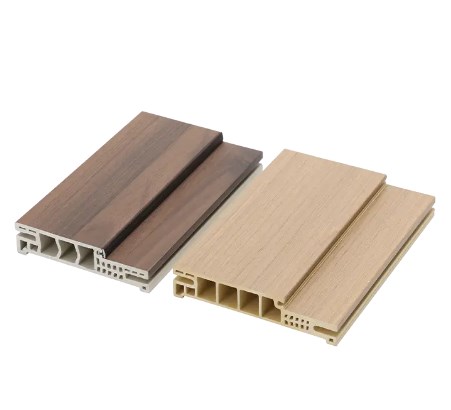With the popularization of environmental protection concepts and the continuous upgrading of the building decoration industry, WPC decoration material is gradually becoming a new favorite for interior and exterior decoration. WPC decoration material, with its unique material structure, excellent performance, and diverse application scenarios, is changing the landscape of traditional decoration materials, bringing new possibilities to architectural design and home decoration.
WPC Decoration Material Composition and Performance Advantages
WPC decoration material is a composite material made by combining natural wood powder or wood fiber with high-molecular plastics in a certain proportion. Its core advantage lies in combining the natural texture of wood with the durability of plastics. The composite ratio, processing technology, and surface treatment methods directly affect its physical properties and decorative effect.
In terms of performance, WPC material possesses moisture-proof, corrosion-proof, mildew-proof, and UV-resistant properties, making it perform excellently in outdoor environments. Compared to traditional wood, it has higher weather resistance and stability, effectively resisting expansion, cracking, or deformation caused by climate change. At the same time, the anti-slip and wear-resistant properties of WPC material make it widely used in flooring, railings, and outdoor landscape decoration.
Processing Technology and Surface Treatment of WPC Decorative Materials
The processing technology of WPC decorative materials mainly includes extrusion molding, compression molding, and injection molding. Through precise equipment control and formula optimization, WPC materials can achieve complex shapes and simulated surface textures. Modern WPC products are also constantly innovating in surface treatment. Through hot pressing, sanding, film coating, and UV coating, the material surface not only has the visual effect of natural wood grain but also enhances its wear resistance, weather resistance, and stain resistance.
The development of surface treatment technology makes WPC materials visually and tactilely similar to natural wood while maintaining the stability and protective properties of plastics. This combination of aesthetics and practicality is the key factor in the rapid popularization of WPC decorative materials in building and home decoration.

Application Scenarios of WPC Decorative Materials
WPC materials have extremely wide applications, ranging from indoor floors, walls, and ceilings to outdoor gardens, terraces, railings, and landscaped walkways. Its excellent waterproof, corrosion-resistant, and slip-resistant properties make it outstanding in outdoor environments, while its easy processing and high customizability meet the aesthetic and personalized needs of interior decoration.
In public buildings and commercial spaces, WPC materials, with their high strength and wear resistance, have become an ideal choice for flooring, wall panels, and decorative moldings. Furthermore, the environmentally friendly properties of WPC materials align with the concepts of green building and sustainable development, leading more and more designers and construction companies to incorporate it into their building material selection standards.
The Environmental Value and Sustainable Development of WPC Decorative Materials
Environmental protection is one of the key values of WPC materials. WPC is processed using renewable wood flour and plastic waste, which not only effectively utilizes resources but also reduces the pressure on natural timber logging. The material itself does not contain harmful substances, and there is no formaldehyde release during use, meeting modern indoor air quality and health standards.
In terms of sustainable development, WPC materials can have their lifespan extended through recycling, realizing the concept of a circular economy. This green and environmentally friendly characteristic not only meets consumers' needs for a healthy life but also provides new ideas for the sustainable development of the building decoration industry.
WPC decorative materials, with their unique material properties, superior performance, and wide range of applications, are becoming a new trend in the building decoration industry. Their moisture and corrosion resistance, environmental sustainability, ease of processing, and diverse designs allow them to balance aesthetics and practicality in both interior and exterior decoration. In the future, with technological upgrades and increasing market demand, WPC materials will continue to lead the innovation trend in decorative materials, creating more value for building and living spaces.
Recommended News